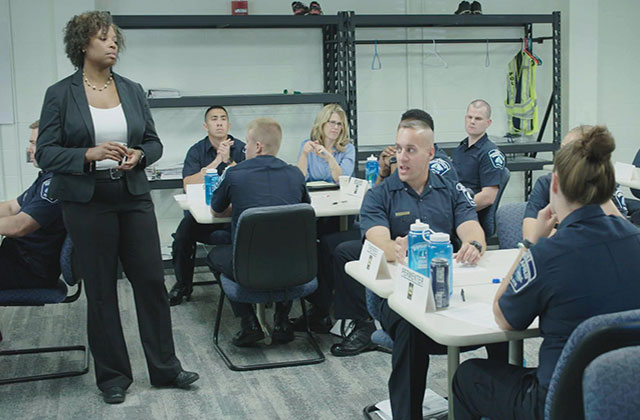What would public safety look like if more women were in leadership roles? The upcoming PBS documentary, “Women in Blue,” argues that police interactions with the public would be less deadly, more community-centered, and those police departments would be more diverse if women led. By looking at five women in the Minneapolis Police Department (MPD) from 2017 to 2020, the film depicts the intersection of gender, race and violence in law enforcement.
Directed by Deirdre Fishel, the film sets its tone opening with a montage of police class photos, that show only white men graduating for decades. The former police chief Janeé Harteau—MPD’s first woman and openly gay chief—candidly states that the culture of policing in her city is one of harm.
“Starting in the ‘90s, law enforcement has long been the culture of disrespect and discrimination,” Harteau says. “Most often, as acts of violence against people of color.”
Beginning with the May 2020 killing of George Floyd, Fishel takes viewers on a three-year tour of that violence. When the voice of Black officer Alice White—whom the film says is one of less than a dozen Black women MPD officers, and who leads procedural justice trainings for her department—speaks about watching Floyd’s devastating video, it’s clear that she’s the real star of the show.
“As I watched the video, I kept thinking to myself, am I truly going to watch a man die on TV,” says White. White’s connection to the community she policies makes her most compelling; she grew up there. And the fact that White is one of six, out of 850 MPD officers total, according to the film, makes her perspective the most grounding. Sadly, White has witnessed a lot of damage to Black lives during her tenure on the force.
Then there’s 24-year old Jamar Clark, a Black man shot and killed by police in November 2015 after a scuffle with an officer; the two officers involved were cleared of any wrongdoing. White, who grew up during the 1990s’ “Fuck the Police” era, says Clark’s case forced her to chose a side: Would it be Black or blue? Two years later in 2017, during an intimate conversation with her teenage daughter Darah about her job—the same year a white woman, Justine Ruszczyk Damond, is shot and killed by Mohamed Noor, a Black officer—White seems to have taken a position.
When people ask White where she works, she tells Darah, “I say I work for the city.”
For years, that city cleared white officers of any wrongdoing that involved police shooting Black people—such as Thurman Blevins—until April 2019, when Noor, a Black man, became the first cop in decades to be convicted of murder in Minneapolis. Noor was sentenced to 12.5 years in prison.
By the time the film gets to 2020, viewers are reminded of last summer’s demonstrations with a burning police precinct and masked demonstrators demanding that the police be defunded. As the city has changed, so have White and her daughter: White has been promoted from officer to sergeant and leans hard into her new position, and Darah has taken to the streets to protest.
“It’s important for the Black community to see women who look like me in this role,” White says. “Even as a police sergeant, I know what that fear is like when police get behind me. I just tell people, don’t be nervous. I don’t want to add to the trauma.” No man featured in the film ever uttered such words, and that’s the point.
“Women in Blue” premieres on PBS’ Independent Lens and will stream on the PBS Video App on February 8, 2021, at 10 p.m. ET.
Watch the trailer below:
